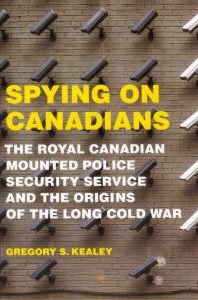There was a casual brutality to the old RCMP Security Service. Mounties for decades kept Canadians under surveillance, confusing dissent with subversion, compiling mountains of neatly typed files. To read declassified reports today is to be struck by the numbing bureaucracy of the exercise. Surveillance reports were blandly passed from desk to desk, like the Department of Fisheries counting salmon stocks.
Why would they spy on Alberta publisher Mel Hurtig, or the president of the British Columbia Teachers’ Federation? Nobody asked. Why watch La Presse editor Jean-Louise Gagnon or Manitoba premier Howard Pawley, who fell under surveillance as president of the Winnipeg’s 1961 Fair Play for Cuba Committee?
“We weren’t plotting anything,” Pawley told Blacklock’s in a 2014 interview. “I had never been to Cuba. The surveillance was a useless expenditure. What was the purpose of it?”
Prof. Gregory Kealey of the University of New Brunswick documents the birth of domestic surveillance in Spying on Canadians, before the RCMP Security Service hit its stride in postwar years. The story is dark and disturbing, and little known.
Canadians instantly recognize the CIA and Britain’s MI5 as dramatized in film, fiction and folklore. Popular culture overlooks our own history of domestic surveillance. Spying on Canadians turns on the lights. It is an absorbing account of a hammer in search of a nail.
“One thing the historical record now clearly shows is that from its inception the RCMP has equated dissent with the foreign-born,” writes Kealey. “Indeed, the issue of ethnicity is crucial to the understanding of the Canadian security regime. It comes into play both in terms of the people targeted by the RCMP, and those doing the targeting.”
Government surveillance dates from the 1868 assassination of D’Arcy McGee, a crime attributed to Irish nationalists. Parliament created the Dominion Police. “Its mandate included the protection of Parliament and other government buildings, the investigation of federal offences such as mail theft and counterfeiting, and most importantly for our purposes, secret service work,” notes Spying On Canadians.
The Dominion Police even hired private detectives to keep tabs on the Irish, and later Slavic immigrants, with a keen focus on trade unions. “No systematic account of the work of these first secret agents has as yet turned up,” writes Kealey.
The force was disbanded as ineffectual in 1920 – Dominion Police proved useless in the 1916 fire that destroyed Parliament – and surveillance duties were assigned to the RCMP. “Canada’s security and intelligence system had been put in place,” says Spying on Canadians. It continues today.
Kealey recounts early files obtained through the 1983 Access To Information Act in attempting to piece together the growth of a spy network. There were characters like Franco Zanetti, aka Frank Zaneth, aka Harry Blask, aka James Laplante, an Italian-born homesteader in Saskatchewan who joined the Mounties in 1917. Zanetti’s specialty was infiltrating trade unions. He retired in 1951 as an assistant commissioner.
“It is strange indeed that we should have permitted a system of espionage to be developed here in Canada,” James Woodsworth, co-founder of the Cooperative Commonwealth Federation, wrote in 1922. Observes Spying on Canadians: “Years later the elaborate secret service system erected primarily to fight labour and the Left remains as much an enigma for us in its current post-Cold War CSIS guise as the RCMP secret service was for Woodsworth.”
By Holly Doan
Spying on Canadians: The Royal Canadian Mounted Police Security Service and the Origins of the Long Cold War, by Gregory S. Kealey; University of Toronto Press; 256 pages; ISBN 9781-48752-1585; $29.95






